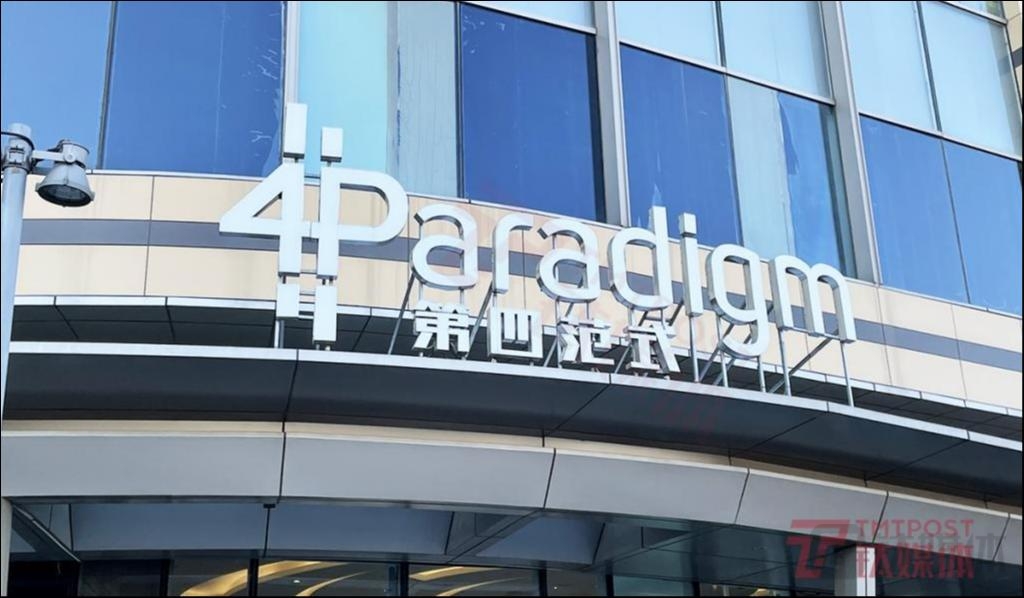
Fourth Paradigm's Headquarters in Beijing
The Hong Kong Stock Exchange disclosed the post-hearing dataset of Beijing Fourth Paradigm Technology last Thursday, which means that the company is about to be listed on the stock exchange.
On July 5, the China Securities Regulatory Commission` (CSRC) gave a green light to the Hong Kong IPO plan of Fourth Paradigm.
TiPost learns that the company will start public roadshows and stock offerings, with the listing expected to be completed within one month at the earliest.
Based on the timing of the listing process of peer companies, Fourth Paradigm is expected to be listed on the Hong Kong Stock Exchange around October this year, becoming the "first stock of decision-making AI software" and the second AI software unicorn to float an IPO in Hong Kong after SenseTime. Fourth Paradigm is valued at $3 billion.
Fourth Paradigm, established in 2014, mainly serve enterprises. The company focuses on decision-making AI and generative AI, providing platform-centered AI solutions to help enterprises achieve rapid and scalable AI transformation and landing, discover hidden patterns in data, and comprehensively enhance their decision-making capabilities.
According to data from China Insights Consultancy, the market size of decision-making AI in 2022 in China reached 53.2 billion yuan, and is estimated to reach 72.4 billion yuan in 2023 and 210.4 billion yuan in 2027. Fourth Paradigm claims that based on the revenue in 2022, it holds the largest market share in the platform-centered decision-making AI market, a sub-segment of the AI market, in China.
Currently, Fourth Paradigm's software service solutions have been applied in sectors such as finance, retail, manufacturing, energy and power, telecommunications, and healthcare.
In 2022, the energy and power industry contributed 20.3% of the company’s total revenue, while the financial sector contributed 16.9%. Additionally, the company has 49 large customers, including Fortune Global 500 companies and listed companies.
As of now, Fourth Paradigm has not yet turned a profit. According to the prospectus, in 2020, 2021, and 2022, it achieved revenues of 942 million yuan, 2.02 billion yuan, and 3.08 billion yuan, respectively, with year-on-year growth rates of 105.0%, 114.2%, and 52.7%. The net losses in 2020, 2021 and 2022 were 750 million yuan, 1.80 billion yuan, and 1.65 billion yuan, respectively. The adjusted net loss (measured by non-International Financial Reporting Standards) reached 504 million yuan last year.
In the latest first quarter of 2023, Fourth Paradigm achieved revenues of 644 million yuan, a year-on-year growth rate of 33.6%. The increase in revenue was mainly due to the expansion of the user base and increased user spending. The net loss during the same period reached 304 million yuan, expanding by around 11% compared to the first quarter of 2022.
The company's revenue is divided into two parts: the Prophet platform and related products, as well as application development and other services. However, the proportion of revenue from the Prophet platform and related products has been continuously declining, from 65.7% in 2020 to 50.3% in 2021, and further down to 48.4% in 2022. The company stated that the expansion of its user base in 2021 and 2022 led to an increased demand for customized AI applications, which drove the increase in the proportion of application development and other services.
With the popularity of ChatGPT worldwide, Fourth Paradigm announced its technological breakthrough in the field of generative AI. In March of this year, it launched SageGPT, an enterprise-level generative AI product designed for business scenarios. It has multimodal interactive capabilities and enterprise-level AI tool features, capable of handling queries and tasks in the form of videos, images, speech, text, etc. It is more oriented towards the B2B sector and primarily solves productivity issues in vertical industries.
According to the prospectus, similar to the Prophet platform and related products, SageGPT is sold in two ways: software usage licenses deployed on end-users' servers, and the sale of servers and other related hardware pre-installed with SageGPT software.
Currently, SageGPT is not bundled with other products or services provided by Fourth Paradigm. However, as of now, the product is still in the early stages of commercialization, and the company has not disclosed the scale of its revenue.
Fourth Paradigm stated in its prospectus that in the future, AI technology will not be dominated by general AI models, but may be more diversified. General AI models (such as LLM) and specialized AI systems (such as decision-making AI models) will coexist for different purposes, with different value positioning. This makes them more complementary than competitive in practical applications.
In terms of technological research and development, the company’s R&D expenditures in 2020, 2021, and 2022 were 566 million yuan, 1.25 billion yuan, and 1.65 billion yuan, respectively, accounting for 60%, 61.9%, and 53.5% of the total revenue. The prospectus stated that the company needs to invest a large amount of resources (including financial resources) in research and development to lead technological progress, thereby maintaining market innovation and competitiveness of its solutions. Therefore, the company expects R&D expenses to continue to increase.
In addition, Fourth Paradigm also discussed the impact of the U.S. Entity List and the specific details of shareholders' non-listed share exits in its latest prospectus.
- US Export Control: Fourth Paradigm stated that the company faces risks related to international trade policies, geopolitics, and trade protection measures, which may have adverse effects on its business, financial condition, and operating performance. Since March 2 of this year, the U.S. Department of Commerce's Bureau of Industry and Security (BIS) has placed several entities on the Entity List, restricting their ability to purchase or otherwise obtain certain goods, software, and technology. As a precaution, unless or until it receives further clarification from the BIS, the company will assume that all entities located at the addresses provided in the Entity List are subject to restrictions in order to comply with relevant limitations.
- Non-listed shares fully converted to H-shares: On June 14th of this year, Fourth Paradigm submitted an application for the "full circulation" of non-listed shares and has submitted application reports and shareholder authorizations for the non-listed shares to apply for the "full circulation" of H-shares in accordance with the requirements of the CSRC. After the decision of the company's shareholders' meeting, pending approval from the CSRC, the 115,246,250 non-listed shares held by HongShan Venture, Cisco China, Stonebridge 2020, Growing Fame, Guangzhou Yuexiu Nuocheng No. 8 Industrial Investment Partnership (Limited Partnership), CITIC Jiantou Securities, Ningbo Huiyuan, Dongkong Jinlong, LF Beta, etc., will be converted into H-shares at a ratio of 1:1.
Fourth Paradigm’s overseas IPO application has been approved by the CSRC. In fact, it is one of the few approved companies after the CSRC issued the overseas listing rules that came into effect on March 31 of this year. At the same time, this will also promote more AI companies to list in Hong Kong. Currently, many AI companies such as iFlytek and Mobvoi are waiting in line for hearings and approval for listing.
The documents show that the funds raised from Fourth Paradigm's IPO will be used to strengthen basic research, enhance technological capabilities, and develop solutions.
The specific plan includes recruiting over 600 scientists and researchers in the next 5 years, hiring about 300 sales and marketing personnel, purchasing approximately 3,000 to 5,000 high-performance computing servers, and selectively acquiring management software tools that can improve research and development efficiency. In the next 3-4 years, the company will establish three or more new R&D centers in first-tier cities in China. In the next 3 years, strategic investments and acquisitions will be made to implement the company's long-term growth strategy and expand its solutions to cover more vertical industries, etc.
(This article was first published by TiPost App. Reporting by Lin Zhijia.)



